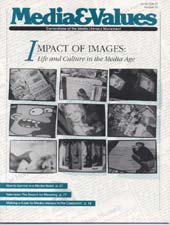STARTING POINT: Today's Image Culture and Why Media Literacy Matters
|
This article originally appeared in Issue# 57
|
In the recent movie Avalon, Barry Levinson's sensitive film portrait of an immigrant family before and after World War II, the delivery of the family's first TV set is portrayed as a significant milestone. Three generations of Krichinskys squeeze together in front of their tiny new television set and stare vacantly at a black and white test pattern. "Just wait," one of the children says, "something will happen."
And it did. Throughout the '60s and '70s, television grew from a diversion in the living room into a national obsession. From moon landings to Leave it to Beaver, a president's assassination to Mr. Clean, media images moved from the background to the foreground of our daily lives.
From the clock radio that wakes us up in the morning until we fall asleep watching the late night talk show, we are exposed to hundreds, even thousands of images and ideas not only from television but now also from newspaper headlines, magazine covers, movies, websites, photos, video games and billboards. Even T-shirts shout their slogans.
The statistics - 162 million TV sets on seven hours a day, 260,000 billboards, 23,076 newspapers and magazines — are only a small part of the story. More significant is the way a media event can bring national life to a screeching halt — a war half-way round the world, congressional investigations, natural and human disasters. In each of these public events, the television camera is not just a neutral recorder but a major player providing the powerful images that shapes not only our perception of the events, but the events themselves.
Until recently, few questioned the increasing dominance of media in our lives. Those who did were inclined to focus on content issues like the amount of sex and violence in television and movies. Others simply urged families to turn the TV off. But the fact is; though you can turn off the set, unless you move to a mountaintop, you cannot escape today's media culture. Media no longer just influence our culture. They are our culture.
Media's pivotal role in our global culture is why media censorship will never work. You may turn off the television set, but you can't "just say no" to the pervading influences that mold all our lives.
What's needed, instead, is a major rethinking that recognizes the paradigm shift from values "in here" provided in the past by family, community and religion, to values " out there" in the consumer culture. The transition from a culture based on images instead of words began, in some ways, with the invention of photography, or maybe even engraving reproduction. But the constant repetition of television's endless images — and technical improvements such as digital image masters that make it possible to invisibly doctor photographs — have accelerated the process. Now it is moving at warp speed.
What is this image world we live in and how does it shape our values? How can we be wholly human and alive when all about us is ephemeral, ever- changing and evanescent? What are the enduring values we must sustain in the midst of a commercialized media environment? What challenges does the image culture hold for the traditional formative institutions of family, school, religion and public life?
These are the questions that undergird this issue of Media&Values. No one can truly deal with media's impact on our lives without raising these deeper issues. In fact, the Center for Media and Values exists to provide the tools for asking these questions and exploring the answers. For most, the first step is learning to stop taking media's presence for granted and recognizing the flood of media that inundates our lives.
Looking Back
Why did the consumer society and television grow up together? How are media images and consumer society connected? What are our images saying to the rest of the world?
Your view of media changes once you realize that it's not an accident that the mass acceptance of television coincided with the period of the United States' post-World War II economic and political dominance. "The American Century" was sparked by this spiffy new sales tool for marketing the products of our intact economy to a bombed- out world.
As we learned to sell, so did we learn to buy. As our own best customers, the magic box sold us the images of a consumer culture. We learned to measure the value and values of our lives against the sensuous images of " the good life" as they flickered across the screen.
But the meaning of media is more than what is shown on the screen, printed page or billboard. Meaning is also supplied by readers/viewers/listeners. Who they are is crucial.
Looking Forward
This understanding that we each bring something and unique to our interaction with media underlines the basic principles of media literacy that this issue examines.
None of us are passive receptors of media's messages. We all bring something of ourselves to the connection. But we can be more than unknowingly involved. We must be actively engaged in the media dialogue. The way to transform the image culture is through media literacy. The goal of media literacy is to empower media users to change the mass media themselves by changing the way they respond to and interact with them.
As someone once said in another context: "Give me the tools and I will finish the job." We don't expect the job to be finished in our lifetimes. But the tools are here.
It is time to begin.



